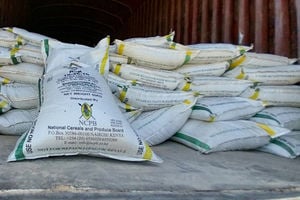
Workers unload bags of subsidised fertiliser from a truck at the National Cereals and Produce Board depot in Elburgon, Nakuru County on February 9, 2024.
Since independence, successive governments have been dogged with scandals in their quest to ensure food security and sufficiency, with imports and fertiliser at the core of most plans.
That is why it does not come as a surprise that President William Ruto’s administration has been caught up in what is developing into a scandal on the quality of subsidised fertiliser.
From the 1970s when Kenya had the plan to build a factory, there has always been a stink on these plans as government officials, politicians, brokers and business people move into profit.
In 1975, the then finance minister Mwai Kibaki struck a deal with an American company to set up a fertiliser factory in Kenya, only for the taxpayers to shoulder the debt of Sh2.4 billion in 2003, 30 years later.
The country entered into a joint venture with N-Ren, an American company, to set up KenRen Chemists and Fertiliser Limited, to produce for the domestic and export market. However, this turned out to be an expensive dream that was never realised—but left the taxpayer with a huge bill.
When Mr Kibaki assumed power as the Head of State, he did not abandon his dream to grow the economy and agriculture was top in his agenda, again his dream was greeted with scandals.
His predecessor President Uhuru Kenyatta’s tenure from 2013 was also riddled with the big promise of subsidised fertiliser.
Former Agriculture Cabinet Secretary Mwangi Kiunjuri was at one time summoned by the Directorate of Criminal Investigations (DCI) to shed light on the procurement scam involving subsidised fertiliser. Mr Kinjuri would later be removed from his position, though no reason was given.
When President Kenyatta announced a reduction in prices of subsidised fertiliser in 2014, he hoped to spur productivity and close the cycle of food shortages. That was never to be.
But when former Auditor General Edward Ouko examined the subsidised fertiliser distribution, he found that Sh4.2 billion remained unpaid — meaning more than one million bags of fertiliser had either been given away for free or that the money was simply swindled.
President William Ruto took an unpopular path – to stop what he called subsidising consumption to focus on production. The hope was to eventually lower the prices of commodities.
The first phase that started last year appears to have gone smoothly but this planting season there have been reports of fake fertilisers supplied from the National Cereals and Produce Board (NCPB) stores. Even though Agriculture Cabinet Secretary Mithika Linturi termed the reports as propaganda, the complaints continued and distribution stopped as investigation continues.
But that is not always the only concern. A report published by Egerton University’s Tegemeo Institute of Agricultural Policy and Development in 2023 found that the implementation model of the fertiliser subsidy programme weakened the private sector by crowding out their investments.
The think-tank on agricultural policy issues established that state subsidies are supposed to be tools of mercy, and meant to cushion the poor in all parts of the country. According to the study, however, fertiliser subsidies have only served sections of the country.
While the programme made fertiliser affordable to farmers, it had the effect of excluding over 30,000 small and medium enterprises and agro-dealers network that has its own well-developed last mile distribution coverage.
If you remove the subsidy element, the study established, that the government and the private sector achieved roughly the same last-mile distribution costs.

Farmers transport bags of subsidised fertiliser from the National Cereals and Produce Board depot in Elburgon, Nakuru County on August 2, 2023.
Then it gets a little more technical in some instances. Historian and journalist John Kamau in 2019 wrote in his Sunday Nation column that if Mr Kenyatta wanted to turn around the agriculture sector and save one of his Big Four agenda initiatives from a dramatic collapse, he needed to address the cadmium question personally and remove the cap placed on the standard on fertiliser imports. Cadmium is a mineral used in the production of fertiliser.
It occurs naturally in phosphate rock, though levels vary depending on where it is mined. Scientists, however, have never agreed on how much cadmium is too much.
There has been snail-pace debate and endless technical parleys on how to address the standard. Significant, however, on February 23, 2018, through a gazette notice lowered the caladium limits allowed from 30 parts per million (ppm) — a measure of the level of cadmium in fertiliser — to 15 ppm.
By doing so, Kenya at the time appeared to have limited itself to just a few places it could buy fertiliser, leaving Kenyan farmers at the hands of a few traders who could only source their fertiliser from only two places — Russia and Saudi Arabia — and at premium prices.
Russian and Saudi Arabian fertilisers have naturally low cadmium levels while North African phosphate producers — Tunisia and Moroccan — have naturally higher levels.
John Kamau argued it has all to do with the politics of fertiliser procurement after some rogue officials began playing in the super league with cartel networks that have for ages controlled the trade.
He noted that while the minutes of a meeting held at the Kenya Bureau of Standards offices on October 10, 2017 said the “decision was not targeted at any individual manufacturer or importer”, it was the Kenyan farmers who were to miss out if a major fertiliser importer was locked out and if we don’t allow competition in pricing.
Global issues have also often had an impact locally. After China abolished a seasonal export duty in 2015, the global prices for DAP recorded a fall.
Records from the World Bank Index of Fertiliser Prices indicate a decline in fertiliser prices ever since the collapse of the leading cartel, the 40-year-old Phosphate Chemicals Export Association (PhosChem) — which then controlled the $30 billion global phosphate market.
Another dominant player, which has been selling fertiliser in Ethiopia at Sh2,000 per 50kg bag, is the Moroccan Office Chérifien des Phosphates (OCP), a government-owned monopoly on phosphate mining, and whose entry into the Ethiopian and Tanzanian markets led to a drastic reduction of DAP prices.
But in Kenya, where it had started to penetrate the market, OCP has from 2018 faced accusations of supplying contaminated fertiliser after its products were detained in Mombasa. The company has always denied the accusations.
Investigators claimed that OCP’s fertiliser contained “mercury” and charged Kenya Bureau of Standards officials with “murder”.
With rising fertiliser prices since 2020, Russia is now using the commodity as a geopolitical tool to entrench itself in various African nations by donating or selling fertiliser.
With the Kenya Kwanza regime making bulk purchases as part of the subsidised fertiliser programme, this is a clear market for Russia, which is battling for space with the other major supplier, Morocco, which has also been sending its diplomats.

Workers offload bags of fertiliser at a National Cereals and Produce Board depot in Elburgon, Nakuru County. Suspicious transactions by one of the companies awarded multibillion-shilling tenders to supply subsidised fertiliser have sparked alarm among financial sector regulators.
Kenya has been a battleground on who will control the fertiliser sector and the three giants that have fought these wars are Russia’s PhosAgro, Maaden of Saudi Arabia and Morocco’s OCP Africa.
The years-long cheap fertiliser dream has always been riddled with among other issues, embezzlement of funds.
In the 2012/13 financial year, more than Sh600 million was sent to Ken-Ren Chemical and Fertiliser plant, a non-existent fertiliser plant started in the 1970s, a State audit report showed.
“Although the government continues to service these debts, it is a matter of concern that a total of Sh644,424,717.42 was incurred during the year on a project which did not take off and against which no value for money was achieved,” Ouko noted in the 2012/13 financial year audit report.
The government paid Sh24 million and Sh619 million as interest and principal towards the settlement of government-guaranteed debts incurred in 1970 on account of Ken-Ren chemical and fertiliser company.
The suppliers — Coppee Lavalin of Belgium and Voest Alpine of Austria — did not deliver any equipment, “except for some crates whose contents were not verified,” according to a parliamentary report.
Three years later, the project collapsed and Ken-Ren went under.
A call placed by a highly-placed government officer on the evening of July 29, 1977 sealed its fate.
The person who delivered the message recalling the American businessman Kenneth Slocum and the top company’s official left no room for negotiation.
Ken-Ren board chairman James S. Mburu, who has since died, was reported to have come “under pressure … (and) developed personal antagonism to Slocum’s activities.”
To date, it has never been made clear why government officials were sabotaging a project that was 65 per cent owned by the State.
Between 1972 and 1973, fertiliser prices had climbed by 75 per cent, forcing many farmers into subsistence production.
Following the oil crisis of 1973, the availability of cheap fertiliser became a major government concern, and during the Jamhuri Day celebrations of 1973, Mzee Kenyatta announced that Kenya would build its fertiliser factory.
Efforts to set up a fertiliser factory would later resurface, with President Kibaki’s administration carrying out a study on its viability.
Kenya even hinted at going it alone after Uganda and Tanzania declined to support a joint venture.
When the Japanese conglomerate Toyota Tsusho Corporation rolled out the first production from its Eldoret plant in August 2016, the country hoped to save Sh3 billion used every year in the importation of fertiliser.
The firm said the plan would significantly cut the cost of the farm input.
As the Deputy President then, Dr Ruto said Kenya killed two birds with one stone: It would no longer import fertiliser by the end of the year once the multi-billion shillings project started operations and it would drastically bring down the cost of production.
But when the plant opened in 2016, farmers complained that the pricing was still beyond their reach at Sh3,200 — which was still way above the global average.
The desire to have cheaper fertiliser still lingered and remained a promise for then President Uhuru Kenyatta and his Deputy William Ruto.
President Ruto while at COP27, that year’s version of the UN’s annual climate change meeting in Sharm El-Sheikh, Egypt, reportedly penned a deal with a multinational to establish a fertiliser plant as his administration steps up efforts to ensure supply of the input to farmers.
President Ruto, who expressed confidence that the company would deliver, believed the move was not only expected to boost the development of green fertiliser thus enhancing food production but also help Kenya's transition to green energy.
The need for a local company stems from constant complaints by farmers about the high cost of fertiliser.
Experts in the agriculture business, however, urge caution on the establishment of such a factory, saying if it relied on imported raw materials, then cutting the costs of fertiliser may not be realised.
As the raging controversy over the alleged sale of substandard fertiliser continues to draw a heated debate, a section of Kenya Kwanza politicians accused unscrupulous traders of selling fake products to sabotage the administration's efforts to subsidise the farm input.
A fortnight ago, the police in Nakuru County seized 34 bags of fake fertiliser in Eldama Ravine and an additional 560 bags in Molo as they were being delivered to NCPB depots.
It is a stinking mess that continues.








